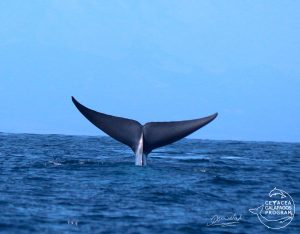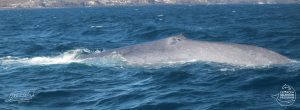Written by Kelly Weaver, Director of External Affairs & Communications at UNC Center for Galapagos Studies

In late September 2021, Galapagos Science Center researcher Dani Alarcón set off on an excursion to attempt something that had not been done before – tagging blue whales in the Galapagos waters. Blue whales are thought to be rising in population globally, yet surprisingly little data has been collected regarding their movements and habits, especially in Galapagos. That is, until now. In collaboration with Dr. Hector Guzman, from the Smithsonian Tropical Research Institute (STRI), expert in megafauna movements and experienced researcher on tagging marine mammals, Dani and her team working in conjunction with the Galapagos National Park recently returned from a 10-day excursion funded by the STRI in the tropical waters surrounding the Galapagos where they are the first researchers to ever successfully tag a blue whale in the Galapagos. The research team managed to tag 10 blue whales in total – enabling a variety of data to be collected moving forward to better understand migratory patterns of the largest animal to ever exist.

Dani started conducting research on whales in Galapagos back in 2012, when she completed her undergraduate thesis with Dr. Judith Denkinger, professor at Universidad San Francisco de Quito, documenting the abundance and distribution of whales in the most productive waters of the Galapagos. After spending nearly 7 months recording which species of whales were found, Dani witnessed first-hand what appears to be more frequent sightings of blue whales, signifying a possible increasing blue whale population in Galapagos.
“Back in the 1980s and 1990s, blue whale reports where scarce and limited to certain seasons of the year, yet our most recent data from the project shows that blue whales are present in Galapagos year -round.” Dani says. “Even as we entered the 2000s reports are still rare but now, with more scientific effort during the past four years, the program has over doubled the information on what we know about these animals in the Galapagos. Global reports indicate that blue whale populations are slowly recovering in numbers, but these animals now face other threats.”
These threats include ocean pollution such as plastics and other pollutants, noise pollution, dangers with boat traffic, incidental or illegal fishing, and a rising ocean climate that could impact food resources for blue whales. Dani is determined to better understand why blue whales continue to come to the tropical waters of the Galapagos, where they come from, and where they are headed, ultimately to protect them and their precious habitat moving forward.
Since 2016 Dani has been the principal investigator on a large-scale project that includes a range of experts in different topics related to conservation of these animals that – alongside direct observations of blue whales – now includes taking samples for genetic and diet analysis and tagging whales to better understand their movements. To conduct this type of research, Dani needs to get within feet of the blue whale, which is challenging and not for the faint of heart.

“We spend many hours searching the wide ocean for the whales, and when we see the water spout from a distance we then switch boats from a larger vessel into a 3 meter Zodiac to get as close as possible to what could be a blue whale ranging from 17-25 meters in length,” Dani explains. “Getting this close to an animal that can weigh close to 200 tons is a complete adrenaline rush,” Dani admits.
By getting this close it allows Dani to take pictures for the photo identification catalogs and Hector to tag the whales when they come to the surface and, in other cases, obtain a skin sample used for genetic testing and isotope analysis which is then brought back to the Microbiology and Genetics Lab at the Galapagos Science Center to be analyzed. At the same time, the team also collects drone footage of the animals to estimate their size and record things such as weather conditions to have a better idea of what is happening during those encounters.
For the first time, with 10 blue whales now tagged, the team will be able to track their exact locations and understand if they stay all year in the tropical waters or possibly travel to the south or north during different times of the year. By better understanding the migratory cycle Dani hopes to understand why blue whales are flocking to the Galapagos waters.
“We hope the tags will last at least a year and we can then better understand if blue whales are here to feed, mate, or even give birth,” Dani explains.
The genetic analysis of the skin samples will help provide answers of where the whales originated from, such as the north near California and Mexico or the south near Chile or even as far as Antarctica. The skin sample is also used for stable isotope analysis which provides data on the blue whale’s diet. This will help to understand more about the structure of the populations in the eastern Pacific.
“My goal is to better understand the population of blue whales in Galapagos through focusing on their diet, genetics, and movements. If we can see what is happening with this species, we can then explore other species of whales,” says Dani.

And we should all care about the health of whales. Not only are they a magnificent species but they are instrumental to the health of the oceans and to even help combat climate change. Whales of all types help with nutrient movement within oceans. Since they are so large, when whales move they are also moving large amounts of water. Furthermore, whale feces are high in iron and other nutrients that produce blooms of productivity in oceans. This creates large amounts of algae that collect carbon from the atmosphere as well as provide food for fish and other ocean life. Whales can also live to be up to 100 years old and have eaten a lot during their lifetime. When whales die, they have collected high amounts of carbon in their bodies that will sink to the bottom of the ocean – in turn helping the environment by sequestering that carbon.
“I feel privileged to work with whales and hope through understanding them better we can protect them for generations to come,” says Dani. Dani’s work is far from over, as she is conducting her doctoral studies in environmental science with Dr. Kathy Townsend from University of Sunshine Coast in Australia, and is already planning her next excursion to find blue whales in February to continue her impactful research.
